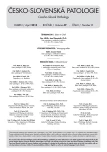Separation of Sperm by Micromanipulator from Unusual Forensic Sample – case report
Authors:
David Vlček 1; Dan Vaněk 2,3; Jaromír Mikeš 4; Martin Kováč 5; Dalibor Kállay 5
Authors‘ workplace:
Kriminalistický a expertizní ústav PZ Košice
1; Forenzní DNA servis, Praha
2; 2. lékařská fakulta UK, Praha
3; Ústav biologických a ekologických věd, Prírodovedecká fakulta, upjš Košice
4; Soudně-lékařské a patologicko-anatomické pracoviště ÚDZS Prešov
5
Published in:
Soud Lék., 58, 2013, No. 2, p. 16-18
Category:
Original Article
Overview
The aim of this study is to provide an information about the method of processing of unusual forensic sample that was submitted for the sexual assault case. We analyzed microscopic sample of vaginal swab stained using the hematoxylin-eosin mixture. After removing the covering glass we failed to collect the sperm cells to the micromanipulator capillary. The cells even started, due to the mechanical stress, to fall apart. We think that the main reason of the microdissection failure is the advanced cell lysis. Due to the negative results of the DNA analysis we defined a set of preventive and corrective actions that would (in case of application) increase the chance of positive identification in similar sexual assault cases.
Keywords:
Forensic – microdissection – DNA identification – sampling – sexual assault
Sources
1. Gill P et al. Forensic application of DNA fingerprints. Nature 1985; 318: 577-579.
2. Elliott K, Hill DS, Lambert C, Burroughes TR, Gill P. Use of laser microdissection greatly improves the recovery of DNA from sperm on microscope slides. Forensic Sci Int 2003; 137: 28–36.
3. Walsh PS, Metzger D, Higuchi R. Chelex 100 as a medium for simple extraction of DNA for PCR-based typing from forensic material. Bio Techniques 1991; 10: 506-518.
4. Vaněk D. Forenzní genetika v procesu dokazování, nakladatelství Forensica, kapitola Zajišťování vzorků pro analýzu DNA na místě činu a v laboratoři, 2011; 38-45.
5. Benschop CC, Wiebosch DC, Kloosterman AD, Sijen T. Post-coital vaginal sampling with nylon flocked swabs improves DNA typing. 2010; 4(2): 115-21.
6. Allen-Hall, D. McNevin. Human tissue preservation for disaster victim identification (DVI) in tropical climates, Forensic Science International: Genetics, 2012; 6(5): 653-657.
7. De Moors A, Georgalis T, Armstrong G, Modler J, Frégeau CJ. Validation of the fluorescence-based Sperm Hy-Liter™ kit as a means to standardize spermatozoa identification in sexual assault cases. Forensic Science International: Genetics Supplement Series 2011; 3(1): e31-e32.
8. Seidl S, Burgemeister R, Hausmann R, Betz P, Lederer T. Contact-Free Isolation of Sperm and Epithelial Cells by Laser Microdissection and Pressuere Catapulting. Forensic Science, Medicine and Pathology 2005; 1(2): 153-158.
9. Vandewoestyne M, Hoofstat D, Nieuwerburgh F, Deforce D. Automatic detection of spermatozoa for laser capture microdissection. International Journal of Legal Medicine 2009; 123(2): 169-75.
10. Vandewoestyne M, Hoofstat D, Nieuwerburgh F, Deforce D. Evaluation of three DNA extracion protocols for forensic STR typin after laser capture microdissection, Forensic Science International: Genetics 2012; 6: 258-262.
Labels
Anatomical pathology Forensic medical examiner ToxicologyArticle was published in
Forensic Medicine

2013 Issue 2
Most read in this issue
- Scuba diver deaths due to air embolism: two case reports
- Separation of Sperm by Micromanipulator from Unusual Forensic Sample – case report
- The use of trigonometry in bloodstain analysis
- An unusual case of penetrating intracranial injury due to scissors
